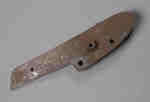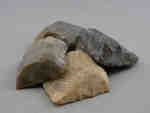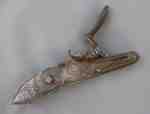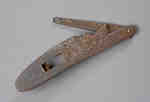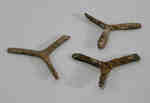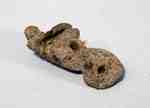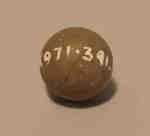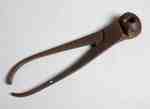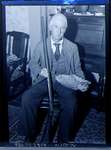Results
- This is a musket action piece that has ornate markings on one side. This item is currently on display at the Battleground Hotel Museum.This is a musket action piece that has ornate markings on one …
- Referred to "The Military Arms of Canada" by The Upper Canada Historical Arms Society and "The British Military Longarms 1715-1815' by D.W. Bailey.Referred to "The Military Arms of Canada" by The Upper Canada Historical …
- This is a piece of flint that was unearthed at one of Niagara’s Battlefields. It would have been used to light a flintlock musket when firing at the enemy.This is a piece of flint that was unearthed at one of …
- A musket action with “TOWER”, a crown and the Royal cipher “GR” engraved on one side.A musket action with “TOWER”, a crown and the Royal cipher “GR” …
- A Brown Bess rifle, commonly called an India Pattern Musket, that has been previously converted from a flintlock to a percussion action. It is a single 39 inch barrel with three ram rod pipes. ThereA Brown Bess rifle, commonly called an India Pattern Musket, that has …
- This is a musket action piece that has ornate markings on one side. This item is currently on display at the Battleground Hotel Museum.This is a musket action piece that has ornate markings on one …
- These are various pieces of a musket action that were unearthed at one of Niagara’s Battlefields. These items are on display at the Battleground Hotel Museum.These are various pieces of a musket action that were unearthed at …
- These prickers, dated 1812, were used as a screwdriver for a musket. It is “Y” shaped, with the top “V” forming the handle and the bottom arm narrowing to fit into the screw. The musket tool was usedThese prickers, dated 1812, were used as a screwdriver for a musket. …
- This musket, circa 1812, is a 3rd Model “Brown Bess” 1790 with an “India Pattern” design. It was a British regulation issue flintlock musket. There are various engravings on the musket that include:This musket, circa 1812, is a 3rd Model “Brown Bess” 1790 with …
- This is a ramrod guide for a British Tower flint-lock musket that was discovered in Niagara.This is a ramrod guide for a British Tower flint-lock musket that …
- This is the cock from an India Pattern musket of the British Army. It is oblonged shaped with a narrow bottom and a wide top. The top has a hole through it, as does the left side centre. Below is a pThis is the cock from an India Pattern musket of the British …
- This musket, circa 1800, is Brown Bess an “India Pattern” design. The ram rod is missing and there is a make-do front sling swivel. The stock is cracked and the proper right side on the bottom extendThis musket, circa 1800, is Brown Bess an “India Pattern” design. The …
- Original donated and identified as a clay musket ball with a circumference of 5cm. It is highly doubtful that such an item would ever be used effectively as a musket ball and is more likely a marbleOriginal donated and identified as a clay musket ball with a circumference …
- This is a lock mechanism measuring 17.7 cm x 3.1 cm, that was made for a tower musket. This lock mechanism was converted to percussion. There are four perforations and markings include “Tower”, a triThis is a lock mechanism measuring 17.7 cm x 3.1 cm, that …
- This is an iron lock mechanism measuring 13.9 cm x 2.5 cm x 3.1cm that is a flintlock from a military pistol. There are seven perforations and markings include “1812”, “2”, and a rampant lion presentThis is an iron lock mechanism measuring 13.9 cm x 2.5 cm …
- This linen bag features red stripes on a white background. The bag was used to carry flints for a flintlock musket. This type of bag was used from the Revolutionary War until 1820. Further research iThis linen bag features red stripes on a white background. The bag …
- This is an American metal musket ball mold of a plier design, dated 1812-1814. It was used to press a musket ball to the size of a bore or rifle, approximately .69 calibre musket balls. The press endThis is an American metal musket ball mold of a plier design, …
- This musket, circa1812, with its ramrod attached, is a flintlock converted to a percussion steel firing mechanism. The barrel is steel and the stock is made of walnut. The marks include: the HanoveriThis musket, circa1812, with its ramrod attached, is a flintlock converted to …
- Individuals, Patterson, James, holding Tecumseh's rifleIndividuals, Patterson, James, holding Tecumseh's rifle







